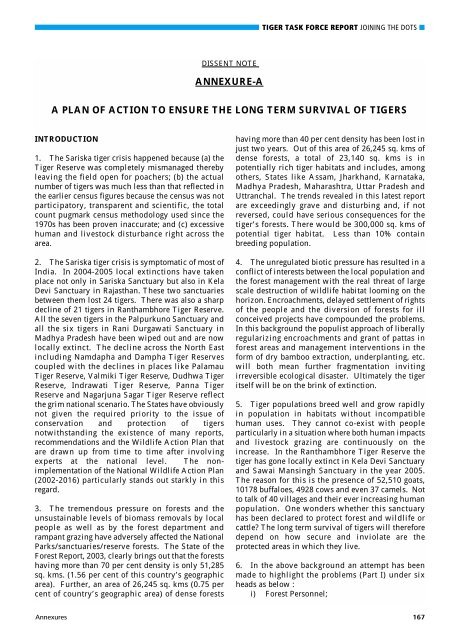Report of the Tiger Task Force - PRS
Report of the Tiger Task Force - PRS
Report of the Tiger Task Force - PRS
You also want an ePaper? Increase the reach of your titles
YUMPU automatically turns print PDFs into web optimized ePapers that Google loves.
TIGER TASK FORCE REPORT JOINING THE DOTS ■DISSENT NOTEANNEXURE-AA PLAN OF ACTION TO ENSURE THE LONG TERM SURVIVAL OF TIGERSINTRODUCTION1. The Sariska tiger crisis happened because (a) <strong>the</strong><strong>Tiger</strong> Reserve was completely mismanaged <strong>the</strong>rebyleaving <strong>the</strong> field open for poachers; (b) <strong>the</strong> actualnumber <strong>of</strong> tigers was much less than that reflected in<strong>the</strong> earlier census figures because <strong>the</strong> census was notparticipatory, transparent and scientific, <strong>the</strong> totalcount pugmark census methodology used since <strong>the</strong>1970s has been proven inaccurate; and (c) excessivehuman and livestock disturbance right across <strong>the</strong>area.2. The Sariska tiger crisis is symptomatic <strong>of</strong> most <strong>of</strong>India. In 2004-2005 local extinctions have takenplace not only in Sariska Sanctuary but also in KelaDevi Sanctuary in Rajasthan. These two sanctuariesbetween <strong>the</strong>m lost 24 tigers. There was also a sharpdecline <strong>of</strong> 21 tigers in Ranthambhore <strong>Tiger</strong> Reserve.All <strong>the</strong> seven tigers in <strong>the</strong> Palpurkuno Sanctuary andall <strong>the</strong> six tigers in Rani Durgawati Sanctuary inMadhya Pradesh have been wiped out and are nowlocally extinct. The decline across <strong>the</strong> North Eastincluding Namdapha and Dampha <strong>Tiger</strong> Reservescoupled with <strong>the</strong> declines in places like Palamau<strong>Tiger</strong> Reserve, Valmiki <strong>Tiger</strong> Reserve, Dudhwa <strong>Tiger</strong>Reserve, Indrawati <strong>Tiger</strong> Reserve, Panna <strong>Tiger</strong>Reserve and Nagarjuna Sagar <strong>Tiger</strong> Reserve reflect<strong>the</strong> grim national scenario. The States have obviouslynot given <strong>the</strong> required priority to <strong>the</strong> issue <strong>of</strong>conservation and protection <strong>of</strong> tigersnotwithstanding <strong>the</strong> existence <strong>of</strong> many reports,recommendations and <strong>the</strong> Wildlife Action Plan thatare drawn up from time to time after involvingexperts at <strong>the</strong> national level. The nonimplementation<strong>of</strong> <strong>the</strong> National Wildlife Action Plan(2002-2016) particularly stands out starkly in thisregard.3. The tremendous pressure on forests and <strong>the</strong>unsustainable levels <strong>of</strong> biomass removals by localpeople as well as by <strong>the</strong> forest department andrampant grazing have adversely affected <strong>the</strong> NationalParks/sanctuaries/reserve forests. The State <strong>of</strong> <strong>the</strong>Forest <strong>Report</strong>, 2003, clearly brings out that <strong>the</strong> forestshaving more than 70 per cent density is only 51,285sq. kms. (1.56 per cent <strong>of</strong> this country’s geographicarea). Fur<strong>the</strong>r, an area <strong>of</strong> 26,245 sq. kms (0.75 percent <strong>of</strong> country’s geographic area) <strong>of</strong> dense forestshaving more than 40 per cent density has been lost injust two years. Out <strong>of</strong> this area <strong>of</strong> 26,245 sq. kms <strong>of</strong>dense forests, a total <strong>of</strong> 23,140 sq. kms is inpotentially rich tiger habitats and includes, amongo<strong>the</strong>rs, States like Assam, Jharkhand, Karnataka,Madhya Pradesh, Maharashtra, Uttar Pradesh andUttranchal. The trends revealed in this latest reportare exceedingly grave and disturbing and, if notreversed, could have serious consequences for <strong>the</strong>tiger’s forests. There would be 300,000 sq. kms <strong>of</strong>potential tiger habitat. Less than 10% containbreeding population.4. The unregulated biotic pressure has resulted in aconflict <strong>of</strong> interests between <strong>the</strong> local population and<strong>the</strong> forest management with <strong>the</strong> real threat <strong>of</strong> largescale destruction <strong>of</strong> wildlife habitat looming on <strong>the</strong>horizon. Encroachments, delayed settlement <strong>of</strong> rights<strong>of</strong> <strong>the</strong> people and <strong>the</strong> diversion <strong>of</strong> forests for illconceived projects have compounded <strong>the</strong> problems.In this background <strong>the</strong> populist approach <strong>of</strong> liberallyregularizing encroachments and grant <strong>of</strong> pattas inforest areas and management interventions in <strong>the</strong>form <strong>of</strong> dry bamboo extraction, underplanting, etc.will both mean fur<strong>the</strong>r fragmentation invitingirreversible ecological disaster. Ultimately <strong>the</strong> tigeritself will be on <strong>the</strong> brink <strong>of</strong> extinction.5. <strong>Tiger</strong> populations breed well and grow rapidlyin population in habitats without incompatiblehuman uses. They cannot co-exist with peopleparticularly in a situation where both human impactsand livestock grazing are continuously on <strong>the</strong>increase. In <strong>the</strong> Ranthambhore <strong>Tiger</strong> Reserve <strong>the</strong>tiger has gone locally extinct in Kela Devi Sanctuaryand Sawai Mansingh Sanctuary in <strong>the</strong> year 2005.The reason for this is <strong>the</strong> presence <strong>of</strong> 52,510 goats,10178 buffaloes, 4928 cows and even 37 camels. Notto talk <strong>of</strong> 40 villages and <strong>the</strong>ir ever increasing humanpopulation. One wonders whe<strong>the</strong>r this sanctuaryhas been declared to protect forest and wildlife orcattle? The long term survival <strong>of</strong> tigers will <strong>the</strong>reforedepend on how secure and inviolate are <strong>the</strong>protected areas in which <strong>the</strong>y live.6. In <strong>the</strong> above background an attempt has beenmade to highlight <strong>the</strong> problems (Part I) under sixheads as below :i) Forest Personnel;Annexures 167
















